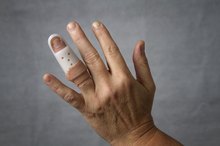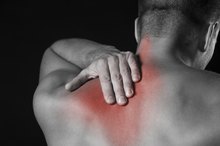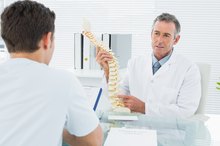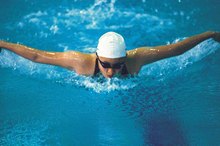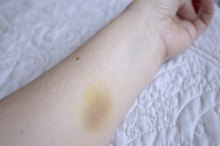How Do You Relocate a Dislocated Shoulder Blade?
A dislocated shoulder blade is one of the most common dislocated joint injuries to the body 12. Symptoms of a dislocation include acute, severe pain, numbness, tingling and limited range of motion. The arm may visually look out of proper alignment. When a shoulder becomes dislocated, the arm pops out of the cup-shaped socket in the shoulder blade, explains MayoClinic.com 1. The shoulder may dislocate forward, backward or downward. Common reasons for a dislocated shoulder include sports injuries and traumatic blows to the shoulder—commonly during a vehicular accident or falls 12.
If you are experiencing serious medical symptoms, seek emergency treatment immediately.
Take medications to decrease pain prior to the shoulder blade being relocated. Muscle relaxants or sedatives are commonly prescribed for this condition. In rare occasions, a general sedative is prescribed, according to MayoClinic.com.
Recovering From Finger Surgery
Learn More
Receive medical treatment to relieve pain and relocate the shoulder. Once the shoulder is treated, the severe pain associated with the injury should subside, reports MayoClinic.com.
Have a medical professional perform closed reduction on the dislocated shoulder 1. The shoulder is manually maneuvered by placing the humerus back into the ball joint. Wear a sling or shoulder immobilizer after the closed reduction procedure to immobilize the shoulder.
How to Care for a Dislocated Shoulder
Learn More
Undergo open reduction surgery if the medical professional is unable to correctly maneuver the arm and shoulder back into position. Surgery is rarely required to correct a dislocation. Still, surgery may be necessary to strengthen tendons and ligaments, and correct any blood vessel or nerve damage.
Tips
Apply ice packs to the site to decrease pain and swelling for several days after the relocation. Switch to heat therapy after a few days. Do not apply heating pads to skin for more than 20 minutes at a time.
Participate in physical therapy to restrengthen the shoulder blade after the injury.
Most shoulder dislocations take a few weeks to heal. If surgery occurred, healing may take several months.
Once your shoulder has been dislocated, you are at a higher risk for the injury to occur again. MayoClinic.com recommends slowly resuming physical activity to avoid reinjury. Continue strength and range of motion exercises to avoid future injuries.
Warnings
Don’t participate in strenuous activity or lift heavy objects until the shoulder heals.
Related Articles
References
- Mayo Clinic: Dislocated Shoulder
- MedlinePlus: Shoulder Injuries
- National Health Service UK. Dislocated shoulder. Updated January 21, 2020.
- American Red Cross. Wilderness and remote first aid: Emergency reference guide. Updated 2014.
- Abrams R, Akbarnia H. Shoulder dislocations overview. In: StatPearls. Updated August 29, 2020.
- Youm T, Takemoto R, Park BK. Acute management of shoulder dislocations. J Am Acad Orthop Surg. 2014;22(12):761-71. doi:10.5435/JAAOS-22-12-761
- Alkaduhimi H, van der Linde JA, Flipsen M, van Deurzen DF, van den Bekerom MP. A systematic and technical guide on how to reduce a shoulder dislocation. Turk J Emerg Med. 2016;16(4):155–168. doi:10.1016/j.tjem.2016.09.008
Writer Bio
Julie Hampton has worked as a professional freelance writer since 1999 for various newspapers and websites including "The Florida Sun" and "Pensacola News Journal." She served in the U.S. Army as a combat medic and nurse for over six years and recently worked as the Community Relations Director for a health center. Hampton studied journalism and communications at the University of West Florida.
